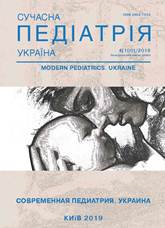Condition of time parameters of heart rhythm in children with small anomalies of the heart
Abstract
Aim. To study the state of the temporal parameters of heart rate variability (HRV) in children with different forms of small anomalies of heart.
Materials and methods. 120 children of school age (6–17 years old) were examined. Depending on the prevalence of the echocardiographic signs of the small anomalies of the heart (SAH), the children were divided into 3 groups: to the first were classified — 49 (40.8%) children who dominated the small anomalies of the left ventricle that is children with additional (false) chords of the left ventricle (LVFCh). The second qroup consisted of 45 (37.5%) children with a predominance of small anomalies of development under the valve structures of mitral valves that is children with insignificant mitral valve prolapse (MVP) without hemodynamic significant regurgitation. And the third group consisted of 26 (21.6%) children with a predominance of small anomalies of aortic valve development — bicuspid aortic valve (BAV). Depending on the age, the examined children were divided into two groups: 6–11 years old (primary school age, n=57) and 12–17 years old (senior school age, n=63). For the comparative analysis of the control group amounted to 36 practically healthy children of the same age. To assess the state of the temporary parameters of HRV in the examined children and adolescents, in addition to general clinical examinations, a multichannel electrocardiogram recording was performed in 12 leads.
Results. Analysis of the results showed, that changes in the temporal parameters of HRV: an indicator of the adequacy of regulation processes (IARP), vegetative rhythm indicator (VRI) and stress index (SI) in groups of children with SAH at the age of 6–11 years old are more expressed than in children of 12–17 years.
Conclusions. This indicates that in children 6–11 years old with MVP VRI and IARP indicating the adequacy of regulation characterizing the relationship between the activity of the sympathetic and parasympathetic parts of the vegetative nervous system increases slightly, unlike children of the same age with false chords of the left ventricle and bicuspid aortic valve and in all clinical groups of children of senior school age, where there was no change in this range.
The research was carried out in accordance with the principles of the Helsinki Declaration. The study protocol was approved by the Local Ethics Committee (LEC) of institution. The informed consent of the patient was obtained for conducting the studies.
References
Gnusaev SF, Belozerov YuM, Vinogradov AF. (2000). Klassifikatsiya malyih anomaliy serdtsa. Vestnik aritmologii. 18: 76.
Domnitskaya TM. (2000). Anomalno raspolozhennyie hordyi serdtsa. Moskva: 98.
Druk IV, Nechaeva GI, Smyalovskiy VE i dr. (2014). Klinicheskaya harakteristika sostoyaniya serdechno-sosudistoy sistemyi u patsientov molodogo vozrasta s displaziey soedinitelnoy tkani v aspekte kardio-tserebralnyih vzaimodeystviy. Spravochnik vracha obschey praktiki.10: 17–26.
Zemtsovskiy EV. (2007). Displasticheskie fenotipyi. Displasticheskoe serdtse. Sankt4Peterburg: 80.
Zemtsovskyi EV, Malev EG, Lobanov MYu, Parfenova NN, Reeva SV, Khasanova SI, Belyaeva EL. (2012). Minor heart anomalies. Russ J Cardiol. 1(93): 77–81.
Korovina HA i dr. (2005). Klinicheskoe znachenie malyih anomaliy razvitiya serdtsa u detey. Lechaschiy vrach. 4: 18–22.
Krivelevich NB. (2001). Narusheniya ritma serdtsa u detey shkolnogo vozrasta s prolapsom mitralnogo klapana i anomalno raspolozhennyimi trabekulami levogo zheludochka. Avtoref. dis. kand. med. nauk. Orenburg.
Kupriyanova OO, Lebedkova SV, Krivelevich NB. (2003). Osobennosti ritma serdtsa u detey s prolapsom mitralnogo klapana i anomalno raspolozhennyimi trabekulami levogo zheludochka. Voprosyi sovremennoy pediatrii. 2;5: 68–73.
Magomedova ShM, Kudaev MT, Omarova AA, Efendieva AM. (2004). Vliyanie prolapsa mitralnogo klapana na techenie VPS i razvitie legochnoy gipertenzii. Tezisyi Vserossiyskogo kongressa Detskaya kardiologiya. 2004. Moskva: 358–359.
Trisvetova EA, Bova AA. (2002). Malyie anomalii serdtsa. Kardiologiya. 1: 9–15.
Foster OV, Shvarts YuG. (2003). Imeetsya li vzaimosvyaz mezhdu stepenyu displazii soedinitelnoy tkani, emotsionalnyim statusom i fibrillyatsiey predserdiy u bolnyih ishemicheskoy boleznyu? Vestnik aritmologii. 33: 18–21.
Haller A. (1760). Elementa physiologiae corporis humani: In 8 t. Lausanne: S. d Arnay. 2;6: 330–332.
Muller D, Agrawal R, Arntz HR. (2006). How sudden is cardiac death? Circulation. 114;11: 1134–1136. https://doi.org/10.1161/CIRCULATIONAHA.106.647933; PMid:16966594
Thakur RK, Klein GJ, Sivaram CA, Zardini M et al. (1996). Purkinje fiber network on the interventricular septum. Anatomic substrate for idiopathic left ventricular tachycardia. Circulation. 93: 497–501. https://doi.org/10.1161/01.CIR.93.3.497; PMid:8565167
Thayer JF, Hansen AL, Saus4Rose E. (2009). Heart rate variability, prefrontal neural function, and cognitive performance: the neurovisceral integration on self-regulation, adaptation, and health. Ann Bihav Med. 37(2): 141–153. https://doi.org/10.1007/s12160-009-9101-z; PMid:19424767
Downloads
Issue
Section
License
The policy of the Journal “MODERN PEDIATRICS. UKRAINE” is compatible with the vast majority of funders' of open access and self-archiving policies. The journal provides immediate open access route being convinced that everyone – not only scientists - can benefit from research results, and publishes articles exclusively under open access distribution, with a Creative Commons Attribution-Noncommercial 4.0 international license (СС BY-NC).
Authors transfer the copyright to the Journal “MODERN PEDIATRICS. UKRAINE” when the manuscript is accepted for publication. Authors declare that this manuscript has not been published nor is under simultaneous consideration for publication elsewhere. After publication, the articles become freely available on-line to the public.
Readers have the right to use, distribute, and reproduce articles in any medium, provided the articles and the journal are properly cited.
The use of published materials for commercial purposes is strongly prohibited.

